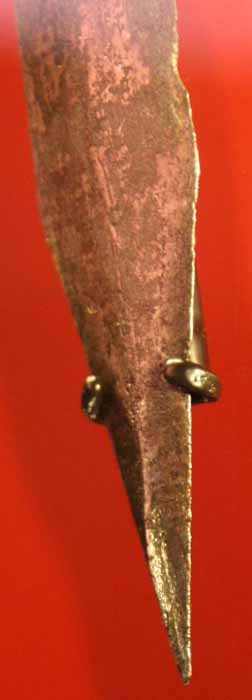| Author |
Message |
|
Levente M.
Location: Hungary Joined: 19 Aug 2009
Posts: 35
|
 Posted: Tue 01 Jul, 2014 2:52 pm Post subject: Reinforced tip? Posted: Tue 01 Jul, 2014 2:52 pm Post subject: Reinforced tip? |
 |
|
Many times when reading about longswords (especially type XVs) i see the term "reinforced tip" come up. What does this mean?
Does the distal taper "reverse" near the tip of the sword, so that it's thicker? Wouldn't that make the thinnest part a potential weak spot?
Or is just that the sword tapers less and has a more uniform thickness?
On a related note, how thick should type XVs and type XVIIIs be at the base with how much distal taper? I know it varies a lot, but some numbers would be nice.
Thanks!
|
|
  |
 |
|
Edward Lee
|
 Posted: Tue 01 Jul, 2014 4:44 pm Post subject: Posted: Tue 01 Jul, 2014 4:44 pm Post subject: |
 |
|
|
I have a del tin type XV Estori visconti sword that has a thick tip. By that I meant the sword got thicker at the tip portion and made the sword very stiff at the tip instead of distal tapering down. I'm not sure if they made it this way historically.
|
|
  |
 |
Ryan Renfro

|
 Posted: Tue 01 Jul, 2014 9:26 pm Post subject: Posted: Tue 01 Jul, 2014 9:26 pm Post subject: |
 |
|
Yes, a reinforced tip is a thickening of the distal taper at the tip. This can be quite minor or quite pronounced. Below is an example of a longsword from Kelvingrove in Glasgow. In some instances the blade geometry remains roughly the same and in others it changes, as can be seen in this gladius at the Royal Armouries in Leeds which transitions from roughly lenticular to diamond section. Another method of reinforcing the tip may be exhibited in one of the best-known type XIXs, which in addition to a 15% increase in thickness is also unsharpened for the last couple of centimeters.
I wouldn't be too concerned about a weak spot before the reinforcement as it usually occurs in conjunction with the final narrowing of the profile.
If you want to get an idea of total distal taper, Kult of Athena provides two thickness measurements for most of the swords it carries. Have a look at some of the more well-researched manufacturers and you'll be able to get an idea of what is fairly representative for a type.
 Attachment: 20.17 KB Attachment: 20.17 KB

 Attachment: 34.17 KB Attachment: 34.17 KB

 Attachment: 37.2 KB Attachment: 37.2 KB

|
|
  |
 |
|
Grayson C.
|
 Posted: Tue 01 Jul, 2014 9:40 pm Post subject: Posted: Tue 01 Jul, 2014 9:40 pm Post subject: |
 |
|
In some cases, a reinforced tip very much means that the distal taper will increase slightly. In a certain light, you could consider any sword whose distal taper ceases to taper before the point termination to have something of a reinforced tip - as long as the ratio of width to thickness becomes closer together, the tip is being reinforced. Where you draw the distinction precisely, however, is broad and open to interpretation - many times it is hard to tell whether such a characteristic was intended by the smith or was simple a result of uneven make. Of course, most of the time people will use this term to refer to swords where the reinforced tip is more obvious, such as an abrupt stop to the taper altogether or as you suggested, a thickening. It all depends on the context of the sword, I guess 
|
|
  |
 |
|
Matthew P. Adams
|
 Posted: Tue 01 Jul, 2014 10:14 pm Post subject: Posted: Tue 01 Jul, 2014 10:14 pm Post subject: |
 |
|
My Albion Fiore's distal taper reverses about 8 inches from the point, but since it continues to taper in blade profile the mass at the tip diminishes. The thinnest point on the sword has enough width to prevent it from becoming a weak spot, and in fact, helps the performance by placing the thinnest portion at the primary percussion node. This is where the sword doesn't vibrate when struck. So the best place to transfer energy to a target, also has the narrowest cross section for ease of penetration.
"We do not rise to the level of our expectations. We fall to the level of our training" Archilochus, Greek Soldier, Poet, c. 650 BC
|
|
  |
 |
|
Levente M.
Location: Hungary Joined: 19 Aug 2009
Posts: 35
|
 Posted: Wed 02 Jul, 2014 1:02 am Post subject: Posted: Wed 02 Jul, 2014 1:02 am Post subject: |
 |
|
Very good info, just what I was looking for.
Thank you!
|
|
  |
 |
|
|

